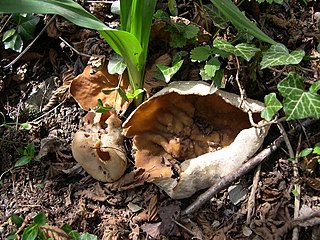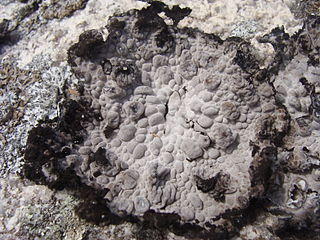
The Cladoniaceae are a family of lichenized fungi in the order Lecanorales. It is one of the largest families of lichen-forming fungi, with about 560 species distributed amongst 17 genera. The reindeer moss and cup lichens (Cladonia) belong to this family. The latter genus, which comprises about 500 species, forms a major part of the diet of large mammals in taiga and tundra ecosystems. Many Cladoniaceae lichens grow on soil, but other can use decaying wood, tree trunks, and, in a few instances, rocks as their substrate. They grow in places with high humidity, and cannot tolerate aridity.

Parmelia is a genus of medium to large foliose lichens. It has a global distribution, extending from the Arctic to the Antarctic continent but concentrated in temperate regions. There are about 40 species in Parmelia. In recent decades, the once large genus Parmelia has been divided into a number of smaller genera according to thallus morphology and phylogenetic relatedness.

Disciotis is a genus of fungi in the family Morchellaceae. Members of this family, characterized by their cup- or bowl-shaped apothecia, have a widespread distribution, especially in northern temperate regions.

Dothideales are an order of bitunicate fungi consisting mainly of saprobic or plant parasitic species.

The Collemataceae are a lichenized family of fungi in the order Peltigerales. The family contains ten genera and about 325 species. The family has a widespread distribution.

Lasallia is a genus of lichenized fungi in the family Umbilicariaceae.

The Orbiliaceae are a family of saprobic sac fungi in the order Orbiliales. The family, first described by John Axel Nannfeldt in 1932, contains 288 species in 12 genera. Members of this family have a widespread distribution, but are more prevalent in temperate regions. Some species in the Orbiliaceae are carnivorous fungi, and have evolved a number of specialized mechanisms to trap nematodes.

The Inocybaceae are a family of fungi in the order Agaricales. Members of this family have a widespread distribution in tropical and temperate areas.

The Baeomycetales are an order of mostly lichen-forming fungi in the subclass Ostropomycetidae, in the class Lecanoromycetes. It contains 8 families, 33 genera and about 170 species. As a result of molecular phylogenetics research published in the late 2010s, several orders were folded into the Baeomycetales, resulting in a substantial increase in the number of taxa.
The Coniochaetales are an order of fungi within the class Sordariomycetes. This order is monotypic and contains a single family, the Coniochaetaceae, historically placed in the order Sordariales. However, this taxonomic placement has been challenged by other authorities, and the Coniochaetales was proposed to include the family Coniochaetaceae. Species in this family are characterized by having germ-slits in the ascospores, a morphological feature that distinguishes them from species in the Sordariaceae. Phylogenetic research in 2006 revealed that four genera in the family Coniochaetaceae, Coniochaeta, Coniochaetidium, Ephemeroascus, and Poroconiochaeta, were not monophyletic, and were all made synonymous with Coniochaeta.

Astraeus is a genus of fungi in the family Diplocystaceae. The genus, which has a cosmopolitan distribution, contains nine species of earthstar mushrooms. They are distinguished by the outer layer of flesh (exoperidium) that at maturity splits open in a star-shape manner to reveal a round spore sac. Additionally, they have a strongly hygroscopic character—the rays will open when moist, but when hot and dry will close to protect the spore sac. Species of Astraeus grow on the ground in ectomycorrhizal associations with trees and shrubs.
Traponora is a genus of lichen-forming fungi in the family Lecanoraceae. The genus was circumscribed in 2009 by Dutch lichenologist André Aptroot, with the Papua New Guinean Traponora asterella assigned as the type, and at that time, only species. Four newly described species were added to the genus in a 2009 publication, a species formerly in Pyrrhospora was transferred to the genus in 2017, and a new species from Australia added in 2018. Traponora lichens are predominantly from Australasia, with all species but one known to occur in Papua New Guinea.

Phacopsis is a genus of lichenicolous (lichen-dwelling) fungi. They are parasites of members of the large lichen family Parmeliaceae, of which they are also a member. Originally proposed by Edmond Tulasne in 1852 to contain 3 species, Phacopsis now contains 10 species, although historically, 33 taxa have been described in the genus. Many of the species are poorly known, some of them having been documented only from the type specimen.
Sprucidea is a genus of four crustose lichens in the family Malmideaceae. Similar to the related genus Malmidea, Sprucidea is characterized by frequently red thalli that contain the secondary compound norsolorinic acid, but differs in the rod-shaped instead of ellipsoid ascospores and in the stalked sporodochia as conidiomata. Sprucidea species are found in rainforest areas in South America and Southeast Asia.

Punctelia rudecta, commonly known as the rough speckled shield or the speckleback lichen, is a North American species of foliose lichen in the family Parmeliaceae. This species can be readily identified by the light color of the thallus underside, the relatively large lobes at the edges of the thallus, and the tiny white pores present on the top of the thallus that are characteristic of the genus Punctelia. The lichen is quite abundant and widespread in the eastern and southeastern United States, although it also occurs in Canada and northern Mexico, but is less common in these regions. The lichen usually grows on bark, and less commonly on shaded rocks. There are several lookalike Punctelia species; these can often be distinguished from P. rudecta by differences in distribution or in the nature of the reproductive structures present on the thallus.

Megalospora is a genus of lichen-forming fungi in the family Megalosporaceae.

Herpothallon is a genus of crustose lichens in the family Arthoniaceae. It has about 50 species.
Harpidiaceae is a small family of lichen-forming fungi, containing two genera and five species. It is of uncertain classification in the Pezizomycotina.

The following outline provides an overview of and topical guide to lichens.
















